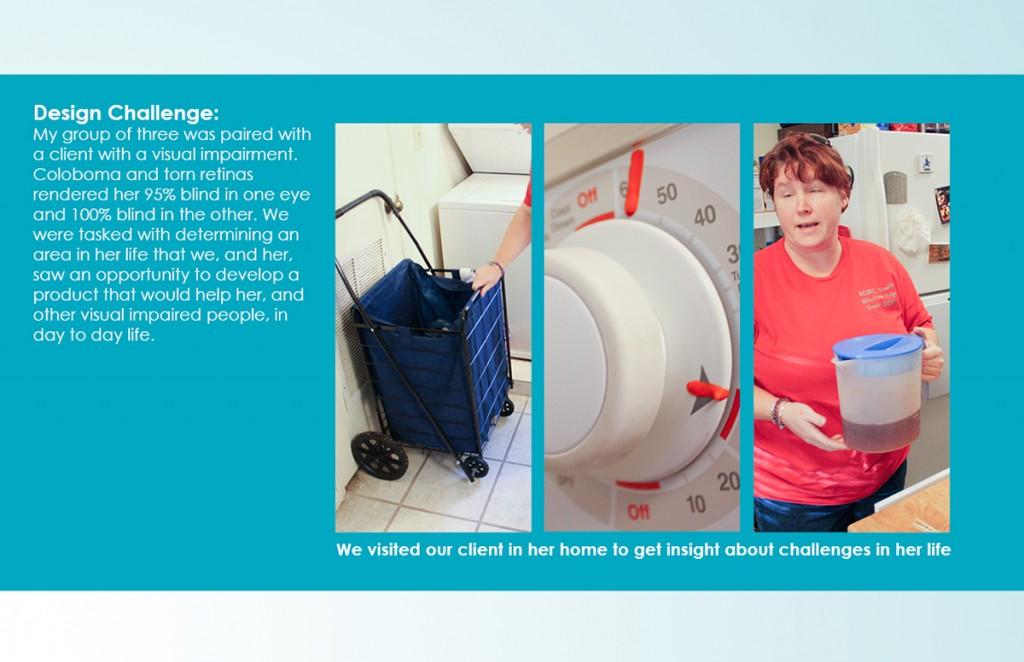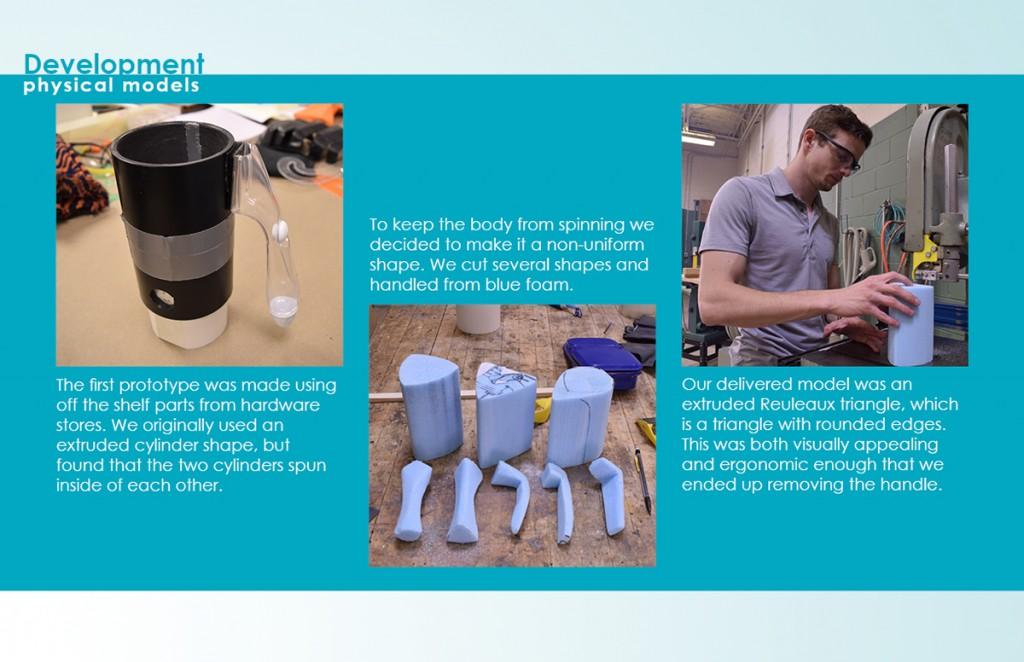 Universal design is the idea that improving our designed environment for people with disabilities isn’t a way of simply adding on something extra but rather supports the improvement of the environment for all users. For example, push buttons that operate doors not only help people in wheelchairs, they are also useful when your arms are full, when you are pushing a stroller, or when you have limited strength. Rather than creating a ‘special’ entrance for those in wheelchairs that has to be accommodated, the overall design is improved so that everyone benefits.
Universal design is the idea that improving our designed environment for people with disabilities isn’t a way of simply adding on something extra but rather supports the improvement of the environment for all users. For example, push buttons that operate doors not only help people in wheelchairs, they are also useful when your arms are full, when you are pushing a stroller, or when you have limited strength. Rather than creating a ‘special’ entrance for those in wheelchairs that has to be accommodated, the overall design is improved so that everyone benefits.
This addresses an issue that Ralph Caplan refers to as being “disabled by design.” If a mobility impairment is a disability because a person in a wheelchair cannot get up a step, it is no longer a disability when there is a ramp. The person’s body has not changed, but the environment is no longer actively disabling them.
 It was with this in mind that Kaleb Thomas, a student in the Industrial Design program at Auburn University, approached the redesign of the measuring cup. For the sighted, the measuring cup is not perfect either and so rather than think of a measuring cup that would be a “blind person’s measuring cup” Thomas decided to simply create a better measuring cup that would also be able to be used by a wider variety of individual bodies. During the entire semester, he and members of his three-person group explored what would be necessary to improve upon the current measuring cup.
It was with this in mind that Kaleb Thomas, a student in the Industrial Design program at Auburn University, approached the redesign of the measuring cup. For the sighted, the measuring cup is not perfect either and so rather than think of a measuring cup that would be a “blind person’s measuring cup” Thomas decided to simply create a better measuring cup that would also be able to be used by a wider variety of individual bodies. During the entire semester, he and members of his three-person group explored what would be necessary to improve upon the current measuring cup.
For the studio, the group was paired with an actual client, in this case a woman with a visual impairment that left her with only 5% vision in one eye and none in the other. Building on the idea of touch as a sense of primary importance to the visually impaired, they envisioned a cylinder within a cylinder that could be telescoped in or out in conjunction with the desired measurement.
They began, as makers often do, by playing with objects. First they experimented with objects found in the hardware store and as they familiarized themselves with the tactile experience began to morph objects they could already find into ideas of objects that needed to be created. The first shift was a move from a more traditional cylindrical shape to a reuleaux triangle (a triangle with rounded corners).
 Carefully considering the way in which measuring cups are used (something people often fail to do when addressing a design problem for everyday objects) they recognized that there needed to be a way to deal with extra ingredient used by accidentally over-filling the cup. This led to the addition of a ‘collar’ that can be placed around the top lip of the measuring cup into which excess liquid could spill without being wasted. In addition, dry ingredients, such as flour, could be scraped away to leave the desired amount and then poured back into the original container. This not only saves from waste but also responds directly to the way that the visually impaired have traditionally made measuring cups work – by feel.
Carefully considering the way in which measuring cups are used (something people often fail to do when addressing a design problem for everyday objects) they recognized that there needed to be a way to deal with extra ingredient used by accidentally over-filling the cup. This led to the addition of a ‘collar’ that can be placed around the top lip of the measuring cup into which excess liquid could spill without being wasted. In addition, dry ingredients, such as flour, could be scraped away to leave the desired amount and then poured back into the original container. This not only saves from waste but also responds directly to the way that the visually impaired have traditionally made measuring cups work – by feel.
By modeling their design in SolidWorks and then printing prototypes, they were able to work back and forth between the visual and physical at each step of the design process. The importance of working in the physical, tactile realm of the actual object was especially important given the client and so moved beyond being a benefit to the design process to becoming an essential part of the evaluation itself.
 The capacity for 3D printing to create small batches with a minimum investment also means that products such as this, which might not have a sufficiently large market share in any particular location to justify the outlay for rotation molding or other production processes for creation, can instead be created on an as-needed basis.
The capacity for 3D printing to create small batches with a minimum investment also means that products such as this, which might not have a sufficiently large market share in any particular location to justify the outlay for rotation molding or other production processes for creation, can instead be created on an as-needed basis.
In addition, feedback from consumers can be quickly and easily addressed before the next cup is produced, rather than having to go through the rest of the faulty (or simply less perfect) stock prior to improvement.
 This object and the processes by which it was created are excellent examples of universal design: improvements in accessibility that benefit everybody. Let us know what you think of this usage of 3D design technology in the 3D Printed Measuring Cup forum thread on 3DPB.com.
This object and the processes by which it was created are excellent examples of universal design: improvements in accessibility that benefit everybody. Let us know what you think of this usage of 3D design technology in the 3D Printed Measuring Cup forum thread on 3DPB.com.
Subscribe to Our Email Newsletter
Stay up-to-date on all the latest news from the 3D printing industry and receive information and offers from third party vendors.
You May Also Like
Wisconsin’s Evology Adds Digital Sheet Forming to Service Roster
Evology, a service bureau based in Wisconsin and specializing in serving strategic sectors like aerospace and defense, has added digital sheet forming (DSF) to its repertoire of manufacturing capabilities. Evology...
Boring Company Alum Score $9M for Advanced Composites Manufacturing
Layup Parts, a Huntington Beach, CA-based startup specializing in on-demand manufacturing of parts made from composites, has received $9 million in its latest financing round. Founders Fund, the VC firm...
Industrial Giant Ingersoll Rand Leads $19M Round Backing Inkbit’s AI-Driven 3D Printing
Inkbit, the Massachusetts-based original equipment manufacturer (OEM) of multi-material, AI-integrated 3D printers, has closed a $19 million financing round. Ingersoll Rand, a US giant in the industrial equipment sector, led...
3YOURMIND & Nigerian Oilfield Services Firm RusselSmith Team Up on 3D Printed Part Inventory
3YOURMIND, the German and U.S. software services provider specializing in digital inventory platforms for additive manufacturing (AM), has partnered with Nigerian oilfield services firm RusselSmith to digitize spare part files...
































